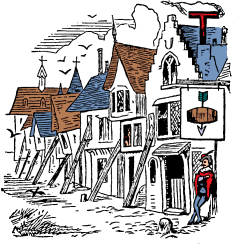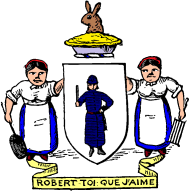HOME
Preface
Introduction
1
2
3
4
5
6
7
8
9
10
11
12
13
14
15
16
17
18
19
20
21
22
23
XVI
CHAPTER XVI.
OF SUPPORTERS.
HE word "Supporter" opens a wide field for consideration in a general way, and when we contemplate how many and various are the persons and things which come under this head, we are tempted to lay down our pen, cut loose the painter of imagination, and drift off into an ocean of speculation too vast to be contemplated, even, by any single-action brain as at present constructed.
The human legs are supporters to most people, and as a rule, except in cases where the natural ones have from some unexplained causes retired from business and been replaced by artificial, very good supporters to get along with. Sometimes, however, they carry us too far; as when, for instance, they take us into somebody else's house to search for his spoons and other unconsidered trifles, and the police step in and interfere with our acquisitive propensities.
Our fathers and mothers in early youth are not unfrequently also our supporters--in fact, we may say almost the best we can have at that early stage of our existence. Failing these, do not the genial authorities of the parish step in? though we fancy but few would for choice accept these last.
Again, some have found a good dinner a capital supporter, especially when hungry; and even a glass of beer has been found not bad upon occasion; nevertheless, too many glasses are apt to prove less a support than a cause of stumbling, and finally to reduce the human form divine from the perpendicular to the horizontal.
A rich and childless uncle, or aunt, who gives us an allowance, can also be used as a supporter; and if to his or her other good qualities he or she should add the peculiarity of dying and leaving all his or her money to you, they prove most efficient.
Other supporters by dozens might be mentioned; but for the present, content with those we have instanced, we will merely say they are none of them the kind we have to deal with in Heraldry.
"Supporters," in Heraldry, are the two figures placed at the sides of shields, and may consist of either man, bird, beast, or fish, or a mixture of all four. They may be borne by Peers of the Realm, Knights of the Garter, Knights of the Grand Cross of the Bath, Nova Scotia baronets, and chiefs of Scottish clans, and are conceded to those sons of peers who bear honorary titles. Bishops, probably in consideration that after all they ought to be able to support themselves on their ecclesiastical revenues, have no Supporters, just as in armorial bearing ladies have no crests.
In England Supporters cannot be borne without the express leave of the sovereign, and in Scotland the same permission must be obtained of Lord Lyon, King-of-Arms. Like gloves, love-making, human ears, and other duplex arrangements, they are generally found in pairs; though a few single Supporters remain in English coats of arms, and in goods of the same description manufactured abroad, they are not uncommon.
Originally the rule was that both Supporters should be alike, but in modern English Heraldry they are frequently different. To quote only one instance, which must be patent to the most unobserving, we may mention the Lion and the Unicorn on the royal banner. Perhaps it was discontent with this arrangement that, among other reasons, caused the celebrated quarrel.
Supporters are usually represented as the figure of a man or an animal, where there is a man or an animal either composite or natural in the shield; but this is not an arbitrary rule, and it frequently varied according to the taste, or want of it, of the Heralds.
In foreign Heraldry, where the Supporters are represented by human beings, they are called "Tenants," in allusion evidently to the rent paid by those individuals so useful in supporting landlords, and it was only when animals performed the duties that they were called Supporters.
Supporters were introduced by Edward III., but were not in general use until the reign of Henry VI.; so that we may conclude that they were Heraldic articles de luxe introduced with the advance of civilization, like Australian beef, Dr. Kenealy, the School Board, and other luxuries.
It has been supposed that Supporters originally represented the servants by whom, at tournaments, the shields of the knights were supported or guarded until such times as they might be wanted. Thus in modern life John Thomas supports or guards the cloaks and great coats at a pic-nic, albeit he would not therefore be considered as a Heraldic Supporter.
The Mantling is an embellishment of scroll-work flowing down on both sides of the shield, and originated in the "Contoise," or scarf, which the knights wrapped round their bodies in the days of coatarmour. Whether this scarf was worn for ornament or warmth, or both, is not clear, though on a cold knight a wrap of silk round the body would be preferable to a rap of a mace on the head.
An interesting question here arises which has often troubled our minds when contemplating effigies and figures in armour--and it is this. What exceedingly draughty wear armour must have been ! Of course, we do not for a moment fancy that the Knights of old had nothing underneath their defensive apparatus--that is of course absurd. Propriety, and we suppose mediæval persons had as keen a sense of it as we at the present day, would alone have demanded it; but, on the other hand, there could not have been much clothing. And yet we never hear of a gallant warrior catching cold. We cannot fancy him tallowing his nose, or sitting with his feet in mustard and water, or taking sweet spirits of nitre before he picked out a soft plank well bestrewn with rushes on which to repose. But they must have had colds sometimes. Catarrh is not a modern invention. Coughs very likely came over with the Conqueror--but we are prepared to bet something handsome that the Saxons, and for the matter of
that the Ancient Britons themselves, could have given an exceedingly good account of them.
But yet there it is--Chivalry and coughing don't seem to go well together. Nevertheless, if the wearer of chain armour on a chilly night, did not catch as good or bad a bold as he could desire, or not desire, all we can say is, that the Knights must have been Arctic ones, and used to it.
But we are digressing from our digression. What did they wear? Well, after all it does not much matter. Still, let us try and evolve their garments.
Of course they had something in the jerkin line--that sounds useful when throwing themselves upon the enemy--and was usually a garment fitting close to the upper portion of the body; then they had trunk hose--at least we hope so--and this corresponded somewhat to our modern breech--(again we had nearly written an unmentionable word, but our readers will know what we mean without forcing us to enter into minute particulars); likewise, they finished off their legs with hose, which were as nearly as possible the stockings of to-day.
Therefore, however good for defensive purposes, it seems to us that armour must have been objectionable wear; heavy and hot in summer, and heavy and cold in winter. Q. E. D.
So, doubtless, the "Contoise," or scarf, came in as a useful vestment to Knights when on the tented field--and in gratitude they hung it on to their shields, and called it a Mantling.
XVI
1
2
3
4
5
6
7
8
9
10
11
12
13
14
15
16
17
18
19
20
21
22
23
Preface
Introduction
HOME
Build: 2019/04/20 14:20:08.59+0900(JST)



